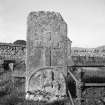Following the launch of trove.scot in February 2025 we are now planning the retiral of some of our webservices. Canmore will be switched off on 24th June 2025. Information about the closure can be found on the HES website: Retiral of HES web services | Historic Environment Scotland
Edderton
Cross Slab (Pictish)
Site Name Edderton
Classification Cross Slab (Pictish)
Alternative Name(s) Edderton Cross Slab
Canmore ID 14743
Site Number NH78SW 3
NGR NH 71911 84204
Datum OSGB36 - NGR
Permalink http://canmore.org.uk/site/14743
- Council Highland
- Parish Edderton
- Former Region Highland
- Former District Ross And Cromarty
- Former County Ross And Cromarty
Edderton 2, Ross & Cromarty, cross-slab
Measurements: H 1.91m, W 0.69m, D 0.20m
Stone type: red sandstone
Place of discovery: NH 7190 8420
Present location: in situ in Edderton churchyard.
Evidence for discovery: first recorded in the churchyard at Edderton around 1830 by James Skene.
Present condition: the top right corner (face A) is missing, and the slab is very weathered.
Description
This rectangular slab is carved in relief and incision on face A and in relief alone on face C. There is a cross on both faces but they are of different types and sizes, linked only by the fact that each is an equal-armed cross separated by a bar from its shaft. On face A, there is a relatively small cross with squared terminals and stepped armpits, outlined by roll moulding, its shaft is set on an enlarged arched base, also outlined by roll moulding, which contains an unarmed figure on a horse, trotting to the left. Beneath an incised line are two horsemen, also riding to the left, each armed with spear, sword and circular shield.
The cross on face C occupies the breadth and almost the length of the slab and is a ringed cross, outlined by roll moulding. The arms have squared terminals and the widely rounded armpits form circles, echoing the central roundel. Like the cross on face A there is no internal ornament.
Date: ninth or tenth century.
References: Skene 1832, 51; ECMS pt 3, 83-4.
Compiled by A Ritchie 2017
NH78SW 3 7190 8420.
(NH 7190 8420) Standing Stone (NR) (Sculptured)
OS 6" map, Ross-shire, 2nd ed., (1907)
An erect cross-slab of red sandstone 6ft 3ins high, 2ft 3ins wide, 8ins thick at the bottom and 5ins thick at the top. The two lower horsemen are concealed by the ground.
J R Allen and J Anderson 1903.
This cross-slab is as described and illustrated by Allen and Anderson.
Visited by OS (R D L) 15 May 1963.
(NH 7190 8420) Cross Slab (NR) (site of)
OS 25" map, (1969)
The cross slab stands at NH 7180 8420 in the graveyard of Edderton Free Church. It does not appear to have been moved in recent times. On the W face is an incised Celtic cross, on the E a Latin cross and a horseman in relief with two incised horsemen partly visible above ground level.
Surveyed at 1:2500.
Visited by OS (J B) 27 February 1981.
Aerial Photography (September 1969)
Oblique aerial photographs centred on Ederton Parish Church and churchyard, taken by John Dewar in September 1969.
Field Visit (October 1978)
Edderton, Cross-slab and church NH 719 842 NH78SW 3 & 4
The present Free Church, built in 1743, may occupy the site of a pre-Reformation church. In the graveyard there is a 'Pictish' cross-slab bearing a cross and equestrian decoration.
RCAHMS 1979, visited October 1978
(OPS 1851-5, ii, 414; Macrae 1923, 289)
Publication Account (1995)
The cross-slab is near the entrance gate, in the fourth row of graves. It is carved in high relief on both sides. On the east side is a cross set on a curved frame, and within the frame a rider on a horse: he is apparently unarmed, and sits on what may be a saddle cloth. Below him are two incised figures on horseback, partly hidden in the ground they carry round shields and spears and are also armed with swords. On the other side of the slab is a large ringed cross on a tall stem, with low bosses in the angles of its arms. There ale no Pictish symbols on this stone, but the riders are similar to those on stones with symbols, such as Shandwick (no. 68), and must be close in date to them.
The white-harled T-plan church built in 1743 was originally the parish church, but became the Free Church when a new parish church was built in Edderton in 1842. It has three galleries, the two at each end now blocked off, and a 1794 pulpit togeth er with ingenious late 18th-century pews which unhinge and fold down to become long communion tables. Outside at the east end is the remains of an earlier church, and at the west end is a roofless burial aisle built in 1637.
Information from ‘Exploring Scotland’s Heritage: The Highlands’, (1995).
















































